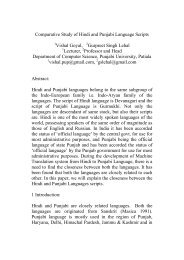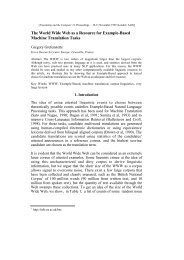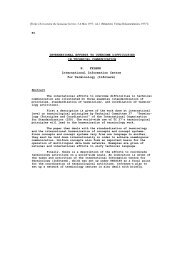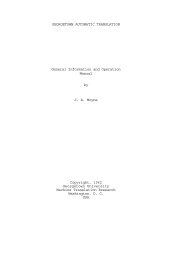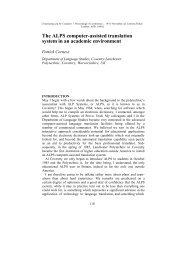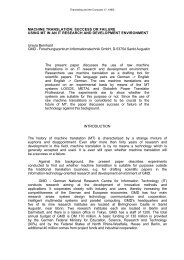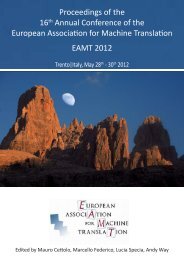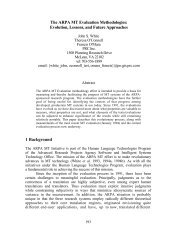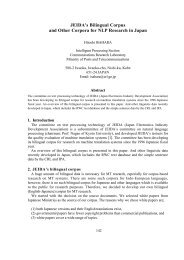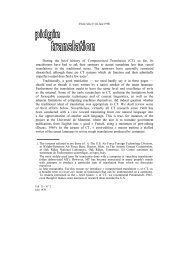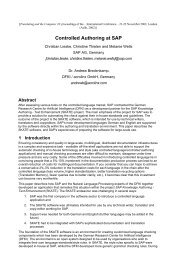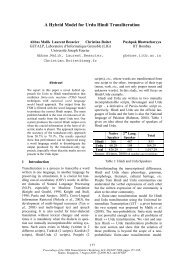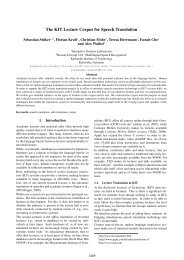Divergence patterns in machine translation between Hindi and English
Divergence patterns in machine translation between Hindi and English
Divergence patterns in machine translation between Hindi and English
Create successful ePaper yourself
Turn your PDF publications into a flip-book with our unique Google optimized e-Paper software.
<strong>Divergence</strong> Patterns <strong>in</strong> Mach<strong>in</strong>e Translation <strong>between</strong> H<strong>in</strong>di <strong>and</strong> <strong>English</strong><br />
R. Mahesh K. S<strong>in</strong>ha<br />
Indian Institute of Technology Kanpur<br />
rmk@iitk.ac.<strong>in</strong><br />
Abstract<br />
The issue of <strong>translation</strong> divergence is an<br />
important research topic <strong>in</strong> the area of<br />
mach<strong>in</strong>e <strong>translation</strong>. An exhaustive study of<br />
the divergence issues <strong>in</strong> MT is necessary for<br />
their proper classification <strong>and</strong> resolution. In<br />
the literature on MT, scholars have exam<strong>in</strong>ed<br />
the issue <strong>and</strong> have proposed ways for their<br />
classification <strong>and</strong> resolution (Dorr 1993,<br />
1994). However, the topic still needs further<br />
exploration to identify different sources of<br />
<strong>translation</strong> divergence <strong>in</strong> different pairs of<br />
<strong>translation</strong> languages. In this paper, we discuss<br />
<strong>translation</strong> <strong>patterns</strong> <strong>between</strong> H<strong>in</strong>di <strong>and</strong> <strong>English</strong><br />
of different types of constructions with a view<br />
to identify<strong>in</strong>g the potential topics of the<br />
<strong>translation</strong> divergences. We take Dorr’s (1993,<br />
1994) classification of <strong>translation</strong> divergence<br />
as the base to exam<strong>in</strong>e the different topics of<br />
<strong>translation</strong> divergence <strong>in</strong> H<strong>in</strong>di <strong>and</strong> <strong>English</strong>.<br />
The primary goal of the paper is to po<strong>in</strong>t out<br />
different types of <strong>translation</strong> divergences <strong>in</strong><br />
H<strong>in</strong>di <strong>and</strong> <strong>English</strong> MT that have not been<br />
discussed <strong>in</strong> the exist<strong>in</strong>g literature.<br />
1 Introduction<br />
The issue of <strong>translation</strong> divergence is a complex<br />
topic <strong>in</strong> mach<strong>in</strong>e <strong>translation</strong> (MT). The <strong>translation</strong><br />
divergence can be def<strong>in</strong>ed <strong>in</strong> terms of language-tolanguage<br />
differences <strong>in</strong> the respective grammars.<br />
Thus a divergence occurs when a sentence <strong>in</strong><br />
language L1 translates <strong>in</strong>to a sentence <strong>in</strong> L2 <strong>in</strong> a<br />
very different form 1 (Dorr 1994: 12). The topic has<br />
been studied from different perspectives <strong>and</strong> a<br />
number of approaches have been proposed to<br />
h<strong>and</strong>le them. It is crucial for any MT system to<br />
identify the nature of <strong>translation</strong> divergences <strong>and</strong><br />
resolve them so as to obta<strong>in</strong> correct <strong>translation</strong>.<br />
The <strong>translation</strong> divergences occur at different<br />
levels <strong>and</strong> affect the quality of the <strong>translation</strong><br />
accord<strong>in</strong>g to the degree of complexity <strong>in</strong>volved <strong>in</strong><br />
a particular <strong>translation</strong> divergence. It has also been<br />
1 It should be noted that what constitutes a <strong>translation</strong><br />
divergence is not dependent upon the <strong>translation</strong><br />
strategy used for mach<strong>in</strong>e <strong>translation</strong>. This is contrary to<br />
the views expressed by one of the reviewers. In this<br />
paper we have taken this def<strong>in</strong>ition of divergence <strong>and</strong><br />
presented structural differences both <strong>in</strong> forward <strong>and</strong><br />
reverse directions irrespective of the MT strategy.<br />
Anil Thakur<br />
Indian Institute of Technology Kanpur<br />
anilt@iitk.ac.<strong>in</strong><br />
noted (Dorr, 1994) that certa<strong>in</strong> types of <strong>translation</strong><br />
divergences are universal <strong>in</strong> the sense that they<br />
exist across the languages whereas certa<strong>in</strong> other<br />
types of <strong>translation</strong> divergences are specific to a<br />
pair of <strong>translation</strong> languages. Therefore, the<br />
<strong>translation</strong> divergences need to be studied from<br />
both across-language <strong>and</strong> language-specific<br />
perspectives. In this paper, we exam<strong>in</strong>e H<strong>in</strong>di <strong>and</strong><br />
<strong>English</strong> <strong>translation</strong> language pair largely from the<br />
perspective of identify<strong>in</strong>g the language-specific<br />
divergecnes. H<strong>in</strong>di <strong>and</strong> <strong>English</strong> differ <strong>in</strong> many<br />
respects <strong>and</strong> hence this <strong>translation</strong> language pair 2<br />
presents a rich source for the study of <strong>translation</strong><br />
divergence <strong>in</strong> MT. These languages also show<br />
significant differences from the po<strong>in</strong>t of view of<br />
socio-cultural perspectives that need to be properly<br />
exam<strong>in</strong>ed. In this paper, we discuss different<br />
aspects of H<strong>in</strong>di <strong>and</strong> <strong>English</strong> grammars that<br />
<strong>in</strong>volve potential areas of <strong>translation</strong> divergences<br />
<strong>in</strong> H<strong>in</strong>di <strong>and</strong> <strong>English</strong> MT. We discuss divergence<br />
issues <strong>in</strong> H<strong>in</strong>di-<strong>English</strong> mach<strong>in</strong>e <strong>translation</strong> <strong>and</strong> the<br />
same <strong>translation</strong> pair is then exam<strong>in</strong>ed for reverse<br />
<strong>translation</strong> from <strong>English</strong>-H<strong>in</strong>di so as to exam<strong>in</strong>e<br />
the nature of the divergence <strong>in</strong> each case.<br />
In the exist<strong>in</strong>g literature, the issue of <strong>translation</strong><br />
divergence for H<strong>in</strong>di <strong>and</strong> <strong>English</strong> MT has not been<br />
exhaustively exam<strong>in</strong>ed. Gupta et al (2003) <strong>and</strong><br />
Dave et al (2001) discuss some of the <strong>translation</strong><br />
divergences perta<strong>in</strong><strong>in</strong>g to <strong>English</strong>-H<strong>in</strong>di MT <strong>and</strong><br />
H<strong>in</strong>di-<strong>English</strong> MT. Dave et al (2001) discusses the<br />
issue with<strong>in</strong> the UNL-based Interl<strong>in</strong>gua approach<br />
<strong>and</strong> only some of the obvious types of divergences<br />
have been discussed. These works do not explore<br />
further areas of divergence. Some of the obvious<br />
divergence types such as thematic divergence,<br />
dative divergence <strong>and</strong> movement divergence have<br />
not been discussed at all. Although the authors<br />
po<strong>in</strong>t out divergences result<strong>in</strong>g from the pro-drop<br />
phenomenon <strong>in</strong> H<strong>in</strong>di <strong>and</strong> the occurrence of<br />
pleonastic subjects <strong>in</strong> <strong>English</strong>, they do not exam<strong>in</strong>e<br />
the issue <strong>in</strong> detail to capture the implications of<br />
2 One of the reviewers has correctly po<strong>in</strong>ted out that<br />
languages other than H<strong>in</strong>di which are equally distant<br />
from <strong>English</strong> can be assumed to exhibit similar or more<br />
such divergences as discussed <strong>in</strong> this paper. Natural<br />
languages are very complex <strong>and</strong> no research on<br />
<strong>translation</strong> divergence can be said to be exhaustive,<br />
particularly at this stage of research.
these language-specific features for other types of<br />
divergences. Also, some of the examples that have<br />
been discussed under head-swapp<strong>in</strong>g divergence<br />
such as promotional <strong>and</strong> demotional divergences<br />
need to be re-looked for their proper<br />
categorization. For <strong>in</strong>stance, on (as <strong>in</strong> “the play is<br />
on” => khel cal rahaa hE {play go PROG be.PR}<br />
has been taken as an adverbial element <strong>in</strong> <strong>English</strong><br />
which has a verbal realization <strong>in</strong> H<strong>in</strong>di. However,<br />
if we recognize this use of ‘on’ (mean<strong>in</strong>g <strong>in</strong> H<strong>in</strong>di<br />
as ‘caalu’) as an adjectival element, the divergence<br />
no longer exists. The H<strong>in</strong>di <strong>translation</strong> (khel caalu<br />
hE {play on be.PR} for the <strong>English</strong> sentence (“the<br />
play is on.”) is equally valid <strong>and</strong> a commonly used<br />
sentence. Gupta et al (2003) discusses only a few<br />
cases of divergence to present rules for unification<br />
of <strong>translation</strong> divergences <strong>in</strong> <strong>English</strong>-H<strong>in</strong>di MT.<br />
Thus we notice that the exist<strong>in</strong>g works are far from<br />
exhaustive both from the po<strong>in</strong>t of view of<br />
classification <strong>and</strong> resolution of different <strong>translation</strong><br />
divergences <strong>in</strong> the context of H<strong>in</strong>di-<strong>English</strong> MT.<br />
In section 2, we discuss different sources of<br />
<strong>translation</strong> divergences <strong>in</strong> H<strong>in</strong>di <strong>and</strong> <strong>English</strong> MT.<br />
Section 3 presents a brief outl<strong>in</strong>e of strategy used<br />
<strong>in</strong> deal<strong>in</strong>g with these divergences <strong>in</strong> our MT<br />
system followed by the conclud<strong>in</strong>g remarks.<br />
2 Translation <strong>Divergence</strong>: Classification <strong>and</strong><br />
Further Issues<br />
Dorr (1993) categorizes <strong>translation</strong> divergences<br />
<strong>in</strong>to two broad types. They are: (A) Syntactic<br />
<strong>Divergence</strong>s, (B) Lexical-semantic <strong>Divergence</strong>s.<br />
They are further subcategorized as follows:<br />
(A) Syntactic <strong>Divergence</strong>: i. Constituent order<br />
divergence, ii. Adjunction divergence, iii.<br />
Preposition-str<strong>and</strong><strong>in</strong>g divergence, iv. Movement<br />
divergence, v. Null subject divergence, vi. Dative<br />
divergence, <strong>and</strong> vii. Pleonastic divergence<br />
(B) Lexical-semantic <strong>Divergence</strong>: i. Thematic<br />
divergence, ii. Promotional divergence, iii.<br />
Demotional divergence, iv. Structural divergence<br />
v. Conflational divergence, vi. Categorial<br />
divergence, <strong>and</strong> vii. Lexical divergence<br />
In Dorr (1994), she has exam<strong>in</strong>ed the structure of<br />
the lexical-semantic divergences <strong>and</strong> proposed a<br />
LCS-based approach for their resolution. This<br />
classification takes <strong>in</strong>to account various sources of<br />
differences <strong>between</strong> a set of <strong>translation</strong> language<br />
<strong>and</strong> captures a large sets of <strong>translation</strong> divergences.<br />
The classification is based on the Government <strong>and</strong><br />
B<strong>in</strong>d<strong>in</strong>g framework (Chomsky 1986, Jackendoff<br />
1990) of l<strong>in</strong>guistic theory which assumes a deep<br />
structure to capture the surface structure variations.<br />
The deep structure functions as the universal<br />
structure, i.e. applicable across languages. Thus<br />
both the classification <strong>and</strong> the resolution of the<br />
<strong>translation</strong> divergences are largely discussed from<br />
the perspective of the universal grammar. The<br />
classification captures the major grammatical<br />
issues <strong>in</strong> <strong>translation</strong> divergence across languages.<br />
However, it also misses a number of po<strong>in</strong>ts that<br />
perta<strong>in</strong> to a particular set of <strong>translation</strong> languages.<br />
The issue of divergence <strong>between</strong> a set of languages<br />
is associated with a number of factors rang<strong>in</strong>g from<br />
l<strong>in</strong>guistic to socio- <strong>and</strong> psycho-l<strong>in</strong>guistic aspects of<br />
the languages <strong>in</strong>volved. Although Dorr’s<br />
classification takes <strong>in</strong>to account many of the major<br />
l<strong>in</strong>guistic factors associated with <strong>translation</strong><br />
divergence, there still rema<strong>in</strong>s a number of po<strong>in</strong>ts<br />
related to both l<strong>in</strong>guistic <strong>and</strong> extra-l<strong>in</strong>guistic<br />
factors that may exist <strong>in</strong> different sets of <strong>translation</strong><br />
languages. Furthermore the parameters of the<br />
classification does not take <strong>in</strong>to account subtle<br />
semantic factors to the extent they are relevant for<br />
the classification of <strong>translation</strong> divergences <strong>in</strong><br />
various languages. Without go<strong>in</strong>g <strong>in</strong>to a detailed<br />
discussion of the different classes <strong>and</strong> categories of<br />
<strong>translation</strong> divergences as proposed <strong>in</strong> Dorr (1993,<br />
1994), we discuss <strong>English</strong> <strong>and</strong> H<strong>in</strong>di <strong>translation</strong><br />
examples that present new sources <strong>and</strong> topics of<br />
<strong>translation</strong> divergence <strong>in</strong> <strong>English</strong>-H<strong>in</strong>di <strong>and</strong> H<strong>in</strong>di-<br />
<strong>English</strong> MT.<br />
2.1 Non-Configurational Nature of H<strong>in</strong>di<br />
<strong>English</strong> is a configurational language that<br />
follows a rigid word order pattern as opposed to<br />
H<strong>in</strong>di which is relatively less rigid <strong>and</strong> exhibit free<br />
word order variation. This is one of the major<br />
sources of divergence <strong>between</strong> a pair of natural<br />
languages. In Dorr’s classification, word order<br />
related <strong>translation</strong> divergences have been discussed<br />
under syntactic divergence. Dave el al (2001)<br />
extends Dorr’s classification to <strong>English</strong>-H<strong>in</strong>di<br />
<strong>translation</strong> pair but do not discuss the implications<br />
of the word order facts at all. For <strong>in</strong>stance, one of<br />
the implications of the word order related<br />
divergence can be noticed with respect to the<br />
<strong>in</strong>terpretation of the question particle ‘kyaa’ (S<strong>in</strong>ha<br />
et al. 2005c) <strong>in</strong> H<strong>in</strong>di. ‘kyaa’ can be used both as a<br />
marker of <strong>in</strong>terrogative pronoun <strong>in</strong> content<br />
question sentences <strong>and</strong> as a question particle <strong>in</strong><br />
yes-no question sentences. Besides certa<strong>in</strong> other<br />
factors such as the category of the verb, it is the<br />
position of occurrence of ‘kyaa’ that <strong>in</strong>dicates its<br />
<strong>in</strong>terpretation one way or the other. The particle<br />
‘kyaa’ <strong>in</strong> the sentence-<strong>in</strong>itial <strong>and</strong> sentence-f<strong>in</strong>al<br />
positions are generally <strong>in</strong>terpreted as question<br />
particle rather than as an <strong>in</strong>terrogative pronoun, as<br />
is evident from the examples shown <strong>in</strong> (1).<br />
(1) a. aap kyaa paDh rahe hEN? {you what read<br />
PROG be.PR} => What are you read<strong>in</strong>g?<br />
b. kyaa aap paDh rahe hEN? {QP you read<br />
PROG be.PR} => Are you read<strong>in</strong>g?
The examples <strong>in</strong> (1) 3 show subtle implications<br />
with respect to the word order facts <strong>in</strong> H<strong>in</strong>di.<br />
Replicative <strong>and</strong> Echo Words<br />
H<strong>in</strong>di, like most of the other South Asian<br />
languages, exhibits the phenomenon of replication<br />
(S<strong>in</strong>ha et al. 2005d) of the lexical items to express<br />
different grammatical functions. The <strong>English</strong><br />
counterparts of these H<strong>in</strong>di constructions do not<br />
resort to replicative structure. This dist<strong>in</strong>ction often<br />
results <strong>in</strong>to a change <strong>in</strong> the syntactic category of<br />
the relevant elements. For <strong>in</strong>stance, we notice that<br />
<strong>in</strong> H<strong>in</strong>di, as <strong>in</strong> (2), the replication of the verb (<strong>in</strong><br />
participial form) denote an adverbial function of<br />
cause. The <strong>English</strong> counterpart of this function is<br />
realized by a gerundive prepositional phrase.<br />
(2) vah bolate bolate thak gayaa. {he speak<br />
speak tired got} => He got tired of speak<strong>in</strong>g.<br />
In this example, the replicative element bolate<br />
bolate is an adverbial clause which is realized<br />
lexically <strong>in</strong> H<strong>in</strong>di <strong>and</strong> is mapped <strong>in</strong> <strong>English</strong><br />
structurally. The reverse <strong>translation</strong> for this<br />
example set does not <strong>in</strong>volve divergence 4 , as <strong>in</strong> (3).<br />
(3) He got tired of speak<strong>in</strong>g. => vah bolane se<br />
thak gayaa. {he speak of tired got}<br />
Another typological feature exhibited by all the<br />
Indian languages is the occurrence of echo words<br />
where a lexical word is partially replicated to<br />
denote a wide range of mean<strong>in</strong>gs with subtle<br />
semantic constra<strong>in</strong>ts. The examples <strong>in</strong> (4-5) are<br />
illustrative.<br />
(4) caay vaay pii kar jaaiye. {tea EW dr<strong>in</strong>k CPP<br />
go} => Have some snacks before go<strong>in</strong>g.<br />
(5) ise Thiik se jaaNc vaaNc lo. {this properly<br />
exam<strong>in</strong>e EW take} => Please exam<strong>in</strong>e it<br />
properly. ise Thiik se jaaNc liijiye.<br />
The echo words generally have no lexical status<br />
<strong>in</strong> the lexicon of the language. However, whenever<br />
an echo word is identical with a lexical word, it<br />
affects the <strong>in</strong>terpretation of the preced<strong>in</strong>g lexicon.<br />
In (4), the use of an echo word ‘vaay’ along with<br />
the ma<strong>in</strong> word ‘caay (tea) gives the sense of light<br />
refreshment. However, this is not a possible sense<br />
<strong>in</strong> which an echo word is used <strong>in</strong> (5). Here the<br />
ma<strong>in</strong> verb jaNcanaa ‘exam<strong>in</strong>e’ occurs with an<br />
echo word that has only an emphatic (or extension)<br />
function but it cannot be exactly expressed <strong>in</strong><br />
3 ACC:Accusative Case, AFF:Affirmative, CAUS:Causative,<br />
CONT:Cont<strong>in</strong>uative Aspect, CPP:Conjunctive Participial<br />
Particle, DAT:Dative Case, DIT:Ditransitive, ERG: Ergative<br />
Case, EW:Echo Word, FU:Future Tense, GER: Gerund,<br />
HAB:Habitual Aspect, IMP:Imperfective Aspect, IMPR:<br />
Imperative Mood, INT:Interrogative, OPT:Optative Mood,<br />
PASS:Passive Particle, PR:Present Tense, PST:Past Tense,<br />
QP:Question Particle, SUBJ:Subjunctive Mood, TRS:<br />
Transitive, VPRT:Verbal Participle.<br />
4 In case of multiple possible <strong>translation</strong>s, if any one<br />
the <strong>translation</strong>s exhibit the same grammatical structure,<br />
it is considered as a case of no divergence.<br />
<strong>English</strong>. In the case of the reverse <strong>translation</strong> from<br />
<strong>English</strong> to H<strong>in</strong>di no divergence is encountered.<br />
2.2 Expressive Elements<br />
Expressive words exist <strong>in</strong> all natural languages<br />
<strong>and</strong> pose difficulty <strong>in</strong> process<strong>in</strong>g, particularly <strong>in</strong><br />
mapp<strong>in</strong>g onto another language. The reason is that<br />
these words do not have exact parallel <strong>in</strong> another<br />
language. Thus the word dhaRaam is only distantly<br />
mapped by ‘bump’ <strong>in</strong> <strong>English</strong>, as <strong>in</strong> (6).<br />
(6) vah dhaRaam se girii. {she ‘dhaRaam’ with<br />
fell} => She fell with a ‘bump’.<br />
The expressive words usually orig<strong>in</strong>ate from the<br />
sound associated with the semantics of the action<br />
verb <strong>and</strong> can be adverbial or verbalized actionverbs<br />
such as ‘tap-tapaanaa’ (drip), ‘khatkhataanaa’<br />
(knock) etc. One may argue this to be<br />
just a lexical gap but <strong>in</strong>deed it is not so. However,<br />
some of these words can be h<strong>and</strong>led <strong>in</strong> the lexicon<br />
but as <strong>in</strong> many cases the mapp<strong>in</strong>g also <strong>in</strong>volves<br />
structural changes, the issue <strong>in</strong>volves a wider scope<br />
of <strong>in</strong>terpretation.<br />
2.3 Asymmetry <strong>in</strong> NP <strong>and</strong> Existential Clauses<br />
The issue of divergence related to the difference<br />
<strong>in</strong> the determ<strong>in</strong>er systems of <strong>English</strong> <strong>and</strong> H<strong>in</strong>di<br />
NPs has not been exam<strong>in</strong>ed <strong>in</strong> the exist<strong>in</strong>g<br />
literature on divergence. <strong>English</strong> has (<strong>in</strong>)def<strong>in</strong>ite<br />
articles that mark the (<strong>in</strong>)def<strong>in</strong>iteness of the noun<br />
phrase overtly whereas H<strong>in</strong>di lacks an overt article<br />
system <strong>and</strong> different devices are used to realize the<br />
(<strong>in</strong>)def<strong>in</strong>iteness of a noun phrase <strong>in</strong> H<strong>in</strong>di. For<br />
<strong>in</strong>stance, mapp<strong>in</strong>g onto articles a-an/the <strong>in</strong> <strong>English</strong><br />
is not lexically realizable from H<strong>in</strong>di (e.g. laRakaa<br />
aayaa => The/*a boy came.). In this connection,<br />
another po<strong>in</strong>t of divergence <strong>between</strong> H<strong>in</strong>di <strong>and</strong><br />
<strong>English</strong> related to there- <strong>and</strong> it-sentences <strong>in</strong><br />
<strong>English</strong> is worth exam<strong>in</strong><strong>in</strong>g. In <strong>English</strong>, there- <strong>and</strong><br />
it-constructions are used to denote existential<br />
sentences (besides others). H<strong>in</strong>di does not have a<br />
pleonastic subject construction <strong>and</strong> the contrast<br />
<strong>between</strong> existential <strong>and</strong> non-existential (mostly<br />
def<strong>in</strong>ite) sentences is realized by several other<br />
ways such as the movement of the noun phrase<br />
from its canonical position <strong>and</strong> the use of<br />
demonstrative elements. Let us look at the<br />
examples <strong>in</strong> (7-8).<br />
(7) kamare meN saaNp hE. {room <strong>in</strong> snake<br />
be.PR} => There is a snake <strong>in</strong> the room.<br />
(8) saaNp kamare meN hE. {snake room <strong>in</strong><br />
be.PR} =>The snake is <strong>in</strong> the room.<br />
We notice that the bare noun phrase saaNp<br />
‘snake’ <strong>in</strong> (7) <strong>and</strong> (8) is mapped by <strong>in</strong>def<strong>in</strong>ite <strong>and</strong><br />
def<strong>in</strong>ite noun phrases <strong>in</strong> <strong>English</strong>. However, the<br />
only difference <strong>between</strong> these two H<strong>in</strong>di sentences<br />
is the respective positions of the subject NP <strong>and</strong><br />
the (place) adverbial phrase. When we look at the
everse <strong>translation</strong> of the same <strong>translation</strong><br />
sentence, the nature of divergence is different.<br />
(9) There is a snake <strong>in</strong> the room. => kamare<br />
meN ek saaNp hE. {room <strong>in</strong> a snake be.PR}<br />
H<strong>in</strong>di does not have a counterpart of “thereconstruction”<br />
<strong>and</strong> the H<strong>in</strong>di grammar has to resort<br />
to a number of devices such as shift<strong>in</strong>g of the<br />
relevant elements <strong>and</strong> deletion of ‘there’ to obta<strong>in</strong><br />
the equivalent of the <strong>English</strong> sentence, as <strong>in</strong> (9).<br />
2.4 Tense, Moods <strong>and</strong> Aspects (TAM)<br />
Another important source of <strong>translation</strong><br />
divergence <strong>in</strong> H<strong>in</strong>di <strong>and</strong> <strong>English</strong> MT is associated<br />
with the difference <strong>in</strong> the manifestation of different<br />
tense, moods <strong>and</strong> aspectual properties of the verb<br />
<strong>in</strong> these languages. For <strong>in</strong>stance, H<strong>in</strong>di uses a<br />
certa<strong>in</strong> type of passive construction that marks a<br />
k<strong>in</strong>d of non-volition function. The <strong>English</strong><br />
counterparts of such H<strong>in</strong>di sentences are only<br />
partially able to express the exact mean<strong>in</strong>g.<br />
(10) raam se galatii ho gaii. {Ram by mistake<br />
be PASS} => Ram made a mistake. <br />
raam-ne galatii kii.<br />
The possible <strong>English</strong> counterpart of the H<strong>in</strong>di<br />
sentence <strong>in</strong> (10) is far from the actual sense <strong>in</strong><br />
which the H<strong>in</strong>di impersonal passive has been used.<br />
The literal sense will be somewhat like: ‘a mistake<br />
got made by Ram un<strong>in</strong>tentionally’. Thus the<br />
reverse <strong>translation</strong> for the same <strong>translation</strong><br />
sentence from <strong>English</strong> to H<strong>in</strong>di <strong>in</strong>volves far more<br />
complex procedure 5 . A somewhat similar<br />
dimension of divergence <strong>between</strong> H<strong>in</strong>di <strong>and</strong><br />
<strong>English</strong> is manifested with respect to the negative<br />
impersonal passive constructions <strong>in</strong> H<strong>in</strong>di <strong>and</strong> the<br />
way they are realized <strong>in</strong> <strong>English</strong>.<br />
(11) raam se calaa nahiiN jaataa. {Ram by<br />
walk not PASS} => Ram cannot walk. <br />
raam cal nahiiN sakataa.<br />
In this case, too, no <strong>translation</strong> divergence occurs<br />
<strong>in</strong> the case of the reverse <strong>translation</strong> <strong>and</strong> the source<br />
H<strong>in</strong>di sentence cannot be obta<strong>in</strong>ed.<br />
In H<strong>in</strong>di, some of the aspectual features of the<br />
verb are realized by verbal <strong>in</strong>flection whereas<br />
<strong>English</strong> resorts to different non-<strong>in</strong>flectional ways<br />
such as phrasal verb or an adverbial element or a<br />
prepositional phrase with gerund as the head, to<br />
realize them. For <strong>in</strong>stance, <strong>in</strong> (12-13), the aspectual<br />
property is identical <strong>in</strong> both the sentences <strong>and</strong> the<br />
difference is located only <strong>in</strong> tense. The habitual<br />
aspect of the tense is reflected by <strong>in</strong>flectional<br />
5 One of the reviewers has argued that such a claim<br />
makes no sense as it can only be made <strong>in</strong> relation to a<br />
given system. The po<strong>in</strong>t we are mak<strong>in</strong>g here is that it is<br />
not possible to derive a sentence to sentence <strong>translation</strong><br />
whatever be the MT system. A <strong>translation</strong> can be only<br />
<strong>in</strong> the form of a number of sentences ‘expla<strong>in</strong><strong>in</strong>g’ the<br />
situation.<br />
morphology on the verb <strong>in</strong> both the tenses.<br />
However, this habitual aspect <strong>in</strong> <strong>English</strong> is realized<br />
by the use of a phrasal verb <strong>in</strong> the case of the past<br />
tense (12) <strong>and</strong> by the use of an adverbial word<br />
‘often’ <strong>in</strong> the case of the present (<strong>and</strong> future) tense<br />
(14). Thus the adverbial element <strong>in</strong> H<strong>in</strong>di is<br />
optional whereas the one <strong>in</strong> <strong>English</strong> cannot be<br />
optional. In (14), we notice that the nonterm<strong>in</strong>ative<br />
aspect is realized by verbal<br />
morphology <strong>in</strong> H<strong>in</strong>di whereas <strong>English</strong> uses a<br />
phrasal structure to realize this aspect.<br />
(12) raam aayaa karataa thaa. {Ram come<br />
CONT be.PST} => Ram used to come.<br />
(13) raam (aksar) aayaa karataa hE.<br />
{Ram often come CONT be.PR} => Ram<br />
*(often) comes.<br />
(14) raam bolataa rahaa. {Ram speak CONT}<br />
=> Ram kept on speak<strong>in</strong>g.<br />
In certa<strong>in</strong> types of conditional clauses <strong>in</strong> H<strong>in</strong>di,<br />
there is opta<strong>in</strong>ality <strong>between</strong> present <strong>and</strong> future/past<br />
tenses. But the <strong>English</strong> counterparts of these H<strong>in</strong>di<br />
sentences always require the verb to occur <strong>in</strong> the<br />
present tense.<br />
(15) yadi tum dillii jaate ho / jaoge to tum<br />
kaamyaab hoge.{if you Delhi go FU / PST<br />
then you successful be.FU} => If you go to<br />
Delhi you will be successful. yadi tum<br />
dillii jaataa ho to tum kaamyaab hogaa. {if<br />
you Delhi go then you successful be.FU}<br />
The reverse <strong>translation</strong> from <strong>English</strong> to H<strong>in</strong>di<br />
will produce only the source H<strong>in</strong>di sentence that<br />
has the verb <strong>in</strong> the present tense form <strong>and</strong> hence<br />
will not <strong>in</strong>volve any <strong>translation</strong> divergence.<br />
2.5 Role of Conjunctions <strong>and</strong> Particles<br />
Another source of divergence <strong>between</strong> H<strong>in</strong>di <strong>and</strong><br />
<strong>English</strong> can be located <strong>in</strong> the case of the use of<br />
different conjunctions <strong>and</strong> particles <strong>in</strong> H<strong>in</strong>di. We<br />
take examples <strong>in</strong>volv<strong>in</strong>g some of these particles <strong>in</strong><br />
H<strong>in</strong>di such as ki, na, <strong>and</strong> yaa. The <strong>translation</strong><br />
divergence <strong>between</strong> H<strong>in</strong>di <strong>and</strong> <strong>English</strong> related to ki<br />
is quite complex (S<strong>in</strong>ha <strong>and</strong> Thakur, 2005b). ki is<br />
ma<strong>in</strong>ly used as a sentence complementizer, but can<br />
also be used to <strong>in</strong>dicate alternate conjunction <strong>in</strong> an<br />
affirmative sentence (16) <strong>and</strong> an <strong>in</strong>terrogative<br />
sentence (18) <strong>in</strong> H<strong>in</strong>di.<br />
(16) siitaa mujhase milii na ki usase. {Sita me<br />
met not him} => Sita met me not him.<br />
(17) raam paDhataa hE ki sotaa hE? {Ram read<br />
PROG be.PR or sleep PRPG be.PR} => Does<br />
Ram study or sleep? kyaa raam<br />
paDhataa hE yaa sotaa hE.<br />
In another <strong>in</strong>stance, yaa (‘or’) is a coord<strong>in</strong>ate<br />
conjunction particle <strong>in</strong> H<strong>in</strong>di that conjo<strong>in</strong>s two<br />
clauses or phrases. However, it can denote a<br />
different function <strong>in</strong> H<strong>in</strong>di depend<strong>in</strong>g on the<br />
punctuation mark used <strong>in</strong> the relevant sentence.
For <strong>in</strong>stance, when yaa (‘or’) is used <strong>in</strong> a sentence<br />
that has an <strong>in</strong>terrogative marker, yaa functions as<br />
an <strong>in</strong>terrogative mark<strong>in</strong>g particle. The contrast is<br />
shown <strong>in</strong> (18-19).<br />
(18) vah dilli gayaa hE yaa kolkata. {he Delhi<br />
went be.PR or Kolkata} => He has gone<br />
either to Delhi or to Kolkata.<br />
(19) vah dilli gayaa hE yaa kolkata? {he Delhi<br />
went be.PR or Kolkata}=> Has he gone to<br />
Delhi or Kolkata? => kyaa vah dillii gayaa<br />
hE yaa kolkata?<br />
In the reverse <strong>translation</strong> of the <strong>English</strong> sentence<br />
<strong>in</strong> (19) back <strong>in</strong>to H<strong>in</strong>di, we notice that the use of an<br />
<strong>in</strong>terrogative particle (kyaa) is obligatory.<br />
2.6 Asymmetry <strong>in</strong> Transitivity <strong>and</strong><br />
Causativity<br />
The divergence related to the morphology-syntax<br />
asymmetry for H<strong>in</strong>di-<strong>English</strong> <strong>translation</strong> pair can<br />
be located <strong>in</strong> the difference <strong>in</strong> the realization of<br />
certa<strong>in</strong> transitive verbs <strong>and</strong> most of the causative<br />
constructions <strong>in</strong> H<strong>in</strong>di <strong>and</strong> <strong>English</strong>.<br />
(20) raam-ne siitaa-ko haNsaayaa.{Ram-ERG<br />
Sita-ACC make-laugh} => Ram made Sita<br />
laugh.<br />
(21) raam-ne siitaa-ko mohan se haNsavaayaa.<br />
{Ram-ERG Sita-ACC Mohan-by make-<br />
laugh-CAUS} => Ram got Mohan make<br />
Sita laugh.<br />
In H<strong>in</strong>di, there are three forms of a verb (<strong>in</strong> this<br />
case haNsanaa ‘laugh’) that are morphologically<br />
derived. (haNsanaa => haNsaanaa =><br />
haNsavaana). The <strong>English</strong> counterparts of these<br />
sentences show that <strong>in</strong> <strong>English</strong>, there is only one<br />
lexical verb ‘laugh’ <strong>and</strong> the other forms are<br />
realized by syntactic processes (such as resort<strong>in</strong>g<br />
to different k<strong>in</strong>ds of verbal constructions). In<br />
H<strong>in</strong>di, haNsaanaa is a transitive verb which does<br />
not have a lexical counterpart <strong>in</strong> <strong>English</strong> (<strong>English</strong><br />
has only the <strong>in</strong>transitive form as a lexical item). In<br />
<strong>English</strong>, it is realized by us<strong>in</strong>g two verbs make <strong>and</strong><br />
laugh. haNsavaanaa is a lexical causative verb <strong>in</strong><br />
H<strong>in</strong>di which <strong>in</strong> <strong>English</strong> is realized by us<strong>in</strong>g three<br />
verbs get, make <strong>and</strong> laugh, with separate argument<br />
structures of their own. The <strong>English</strong> counterpart of<br />
the H<strong>in</strong>di example <strong>in</strong> (21) appears to be a forced<br />
<strong>translation</strong>. In certa<strong>in</strong> cases, it is quite difficult to<br />
obta<strong>in</strong> an exact <strong>translation</strong> of a common H<strong>in</strong>di<br />
ditransitive verb. For <strong>in</strong>stance, <strong>in</strong> (21), the <strong>English</strong><br />
counterpart of the transitive verb pi<strong>in</strong>aa is dr<strong>in</strong>k.<br />
However, H<strong>in</strong>di also has a ditransitive verb<br />
pilaanaa derived from pi<strong>in</strong>aa. <strong>English</strong> does not<br />
have a counterpart of this ditransitive verb.<br />
(22) usane hame paanii pilaayaa. {he-ERG us<br />
water dr<strong>in</strong>k-CAUS} => he gave us water.<br />
usane hame paanii diyaa.<br />
The verb ‘give’ is used because there is no exact<br />
<strong>English</strong> counterpart of the H<strong>in</strong>di verb pilaanaa.<br />
Thus the reverse <strong>translation</strong> <strong>in</strong>volves a far more<br />
complex procedure. Gaps of this type are quite<br />
common <strong>between</strong> H<strong>in</strong>di <strong>and</strong> <strong>English</strong>.<br />
2.7 Stative <strong>and</strong> Progressive Aspect<br />
<strong>English</strong> seems to lack an exact counterpart of<br />
H<strong>in</strong>di stative verb/adjective which is realized by<br />
the progressive aspect marker. In <strong>English</strong>, there is<br />
no dist<strong>in</strong>ction <strong>between</strong> the progressive aspect<br />
denot<strong>in</strong>g sentence <strong>and</strong> its stative counterpart. The<br />
<strong>English</strong> verbs such as sit, st<strong>and</strong>, sleep, <strong>and</strong> wake<br />
fall <strong>in</strong> this category. In H<strong>in</strong>di, they are<br />
dist<strong>in</strong>guished by different lexical form of the<br />
relevant verb.<br />
(23) raam kursii par bEThaa hE. {Ram chair on<br />
sitt<strong>in</strong>g be.PR} => Ram is sitt<strong>in</strong>g on a chair.<br />
raam kursii par bETha rahaa hE.<br />
{Ram chair on sitt<strong>in</strong>g PROG be.PR}<br />
The divergence of this k<strong>in</strong>d seems to <strong>in</strong>volve<br />
both lexical <strong>and</strong> structural aspects of the languages<br />
<strong>in</strong>volved. If ‘sitt<strong>in</strong>g’ is entered <strong>in</strong> the lexicon both<br />
as an adjective <strong>and</strong> a (form of) verb, only then the<br />
source H<strong>in</strong>di sentence can be obta<strong>in</strong>ed <strong>in</strong> reverse<br />
<strong>translation</strong>.<br />
2.8 Participle Modification<br />
The participle modifiers <strong>in</strong> H<strong>in</strong>di are mostly<br />
realized by relative clauses <strong>in</strong> <strong>English</strong>. For<br />
<strong>in</strong>stance, <strong>in</strong> H<strong>in</strong>di, vaalaa is a suffix that, besides<br />
denot<strong>in</strong>g several other functions, also functions as<br />
an adjectival suffix.<br />
(24) kal aane-vaale logoN se mEN nahiiN mil<br />
paauNgaa. {tomorrow com<strong>in</strong>g-of people<br />
with I not meet able to} => I will not be able<br />
to meet the people who are com<strong>in</strong>g tomorrow.<br />
mEN un logon se jo kal aa rahe hEN<br />
nahiiN mil paauNgaa. {I those people with<br />
who tomorrow come PROG be.PR not meet<br />
able to}<br />
In (24), we notice that <strong>in</strong> H<strong>in</strong>di, the noun log<br />
(‘people’) is modified by a participial adjectival<br />
phrase kal aane-vaale that precedes the head noun.<br />
However, <strong>in</strong> <strong>English</strong>, the same is realized by a<br />
relative clause construction that follows the ma<strong>in</strong><br />
clause. In this case, an (adjectival) phrase <strong>in</strong> H<strong>in</strong>di<br />
is realized by a clause <strong>in</strong> <strong>English</strong>. The vaalaaconstruction<br />
<strong>in</strong> H<strong>in</strong>di presents a complex issue <strong>in</strong><br />
itself which cannot be discussed <strong>in</strong> this paper.<br />
2.9 Gerund <strong>and</strong> Participle Clauses<br />
Another significant source of divergence <strong>in</strong><br />
H<strong>in</strong>di <strong>and</strong> <strong>English</strong> MT can be located <strong>in</strong> the way<br />
the various clausal complements <strong>and</strong> adjuncts<br />
(such as verbal participles) <strong>in</strong> H<strong>in</strong>di are realized <strong>in</strong><br />
<strong>English</strong>.
(26) vah aakar khush huaa. {he come-CPP<br />
happy be.PST} He got happy to come.<br />
(26) vah mujhase baat karane (ke liye) aayaa.<br />
{he me talk do for came} He came to<br />
talk to me.<br />
(27) vah yah karane meN samarth nahiiN hE.<br />
{he this do <strong>in</strong> able not be.PR} He is not<br />
able to do this.<br />
(28) vah jaanaa caahataa hE. {he go want} <br />
He wants to go.<br />
In the H<strong>in</strong>di sentences <strong>in</strong> (25-28), the adjunct<br />
verbal clauses <strong>and</strong> complement verbal clauses are<br />
realized by different structures which <strong>in</strong> <strong>English</strong><br />
are mapped by a s<strong>in</strong>gle structure. Thus the reverse<br />
<strong>translation</strong> for this set of examples <strong>in</strong> (25-28) faces<br />
different type of difficulty. In the former case, it is<br />
many-to-one mapp<strong>in</strong>g whereas <strong>in</strong> the latter case, it<br />
is a one-to-many mapp<strong>in</strong>g.<br />
2.10 Clausal Conjunction<br />
Another difference that is manifested <strong>between</strong><br />
H<strong>in</strong>di <strong>and</strong> <strong>English</strong> is with respect to clausal<br />
conjunction where the subord<strong>in</strong>ate clause is used to<br />
express different types of clause <strong>in</strong> H<strong>in</strong>di. In<br />
<strong>English</strong>, they are not always realized by the same<br />
type of clause, rather they are realized by different<br />
devices such as a modal verb.<br />
(29) ho naa ho vah kahiiN gayaa ho. {may be<br />
he somewhere gone SUBJ} => He might<br />
have gone somewhere. vah kahiiN<br />
gayaa hogaa. {he somewhere gone be.FU}<br />
As we notice, the reverse <strong>translation</strong> does not<br />
produce exactly the source H<strong>in</strong>di sentence.<br />
2.11 Mapp<strong>in</strong>g of have-verbs <strong>in</strong> H<strong>in</strong>di<br />
Certa<strong>in</strong> <strong>English</strong> have-sentences are difficult to be<br />
exactly mapped onto H<strong>in</strong>di. Besides its<br />
polysemous nature, have-constructions also<br />
<strong>in</strong>volve structural aspects <strong>and</strong> constitute a case of<br />
<strong>translation</strong> divergence.<br />
(30) a. usameN saahas hE. {he-<strong>in</strong> courage<br />
be.PR} He has courage.<br />
b. usake ti<strong>in</strong> bacche hEN. {he-of three kids<br />
be.PR} He has three kids.<br />
c. usake paas pEse hE. {he-of near<br />
money be.PR} He has money.<br />
Some of the representative examples, as <strong>in</strong> (30),<br />
can show the divergence issues <strong>in</strong>volved <strong>in</strong><br />
translat<strong>in</strong>g the H<strong>in</strong>di counterparts of the <strong>English</strong><br />
have-constructions. In H<strong>in</strong>di, the subject NP occurs<br />
<strong>in</strong> different case forms but they all are mapped<br />
onto <strong>English</strong> by have-verb sentences. In the reverse<br />
<strong>translation</strong> from <strong>English</strong> to H<strong>in</strong>di, although there<br />
will be one-to-many mapp<strong>in</strong>g but the nature of the<br />
divergence will rema<strong>in</strong> the same.<br />
2.12 Had-Counterfactual Clause<br />
In H<strong>in</strong>di, the counterfactual conditional clause is<br />
marked by a conjunction agar/yadi (‘if’) which <strong>in</strong><br />
<strong>English</strong> can be realized either by a had-clause or an<br />
if-clause. In the former case, <strong>translation</strong> divergence<br />
occurs.<br />
(31) agar tum yahaaN hote to ham bhii aate. {if<br />
you here be.SUBJ then we also come-<br />
SUBJ} Had you been here we would<br />
have also come.<br />
In reverse <strong>translation</strong> for the <strong>English</strong> sentence,<br />
the divergence rema<strong>in</strong>s the same.<br />
2.13 Let-sentences<br />
The H<strong>in</strong>di permissive-sentences are mostly<br />
translated <strong>in</strong>to <strong>English</strong> by “let-sentences”, as <strong>in</strong><br />
(32a). However, there are certa<strong>in</strong> wish-sentences<br />
that also occur <strong>in</strong> the form of a let-sentence (32b).<br />
(32) a. use jaane do{him go give}Let him go.<br />
b. calo, khaanaa khaayeN. {go food eat.OPT}<br />
=> Let us go <strong>and</strong> eat now. hameN jaane<br />
aur khaane do. {us now eat let}<br />
The difference <strong>in</strong> the <strong>English</strong> sentences <strong>between</strong><br />
(32a) <strong>and</strong> (32b) is only <strong>in</strong> the use of a pronoun.<br />
The use of first person plural pronoun ‘us’ <strong>in</strong> (32b)<br />
makes the sentence a wish-sentence rather than a<br />
permissive-sentence. Thus the reverse <strong>translation</strong><br />
<strong>in</strong> (32a) does not <strong>in</strong>volve <strong>translation</strong> divergence<br />
whereas <strong>in</strong> (32b), a <strong>translation</strong> divergence occurs.<br />
The nature of this <strong>translation</strong> divergence aga<strong>in</strong><br />
perta<strong>in</strong>s to the gaps <strong>in</strong> the realization of different<br />
verbal <strong>in</strong>flections <strong>and</strong> functions <strong>between</strong> <strong>English</strong><br />
<strong>and</strong> H<strong>in</strong>di.<br />
2.14 News Head<strong>in</strong>gs<br />
The news head<strong>in</strong>gs <strong>in</strong> <strong>English</strong> <strong>and</strong> H<strong>in</strong>di follow<br />
different grammar rules (S<strong>in</strong>ha 2002). In <strong>English</strong>,<br />
generally the present tense form of the verb is used<br />
whereas H<strong>in</strong>di uses past tense from of the verb.<br />
(33) sunaamii meN laakhoN log mare. {tsunami<br />
<strong>in</strong> millions died} => millions die <strong>in</strong> tsunami.<br />
sunaamii meN laakhoN log marate hE.<br />
{tsunami <strong>in</strong> million people die}<br />
In this case, <strong>translation</strong> <strong>in</strong> both the H<strong>in</strong>di-<strong>English</strong><br />
<strong>and</strong> <strong>English</strong>-H<strong>in</strong>di cases <strong>in</strong>volves divergence.<br />
2.15 Optative Sentences<br />
The verb <strong>in</strong> the subord<strong>in</strong>ate clause <strong>in</strong> the<br />
sentences of optative mood <strong>in</strong> H<strong>in</strong>di occurs <strong>in</strong><br />
different forms depend<strong>in</strong>g on the gender, number<br />
<strong>and</strong> person of the subject NP of the subord<strong>in</strong>ate<br />
clause whereas its <strong>English</strong> counterpart rema<strong>in</strong>s<br />
constant (root form of the verb) <strong>in</strong> all the cases. In<br />
this case, the verb form does not <strong>in</strong>dicate tense.<br />
The divergence is triggered by the similarity of the<br />
form of the verb with other tense forms <strong>in</strong> the case<br />
of <strong>English</strong> whereas it is not the case <strong>in</strong> H<strong>in</strong>di.
(34) ham caahate hEN ki raam saphal ho. {we<br />
want be.PR that Ram successful be.OPT} =><br />
We want that Ram succeed.<br />
This type of divergence can be resolved by<br />
tak<strong>in</strong>g <strong>in</strong>to account the semantic type of the verb.<br />
2.16 Indirect Speech<br />
The <strong>in</strong>direct speech sentences <strong>in</strong> H<strong>in</strong>di <strong>and</strong><br />
<strong>English</strong> differ <strong>in</strong> both the form of tense <strong>and</strong> the use<br />
of pronom<strong>in</strong>al elements.<br />
(35) a. raam-ne kahaa ki mEN nahiiN jaauNgaa.<br />
{Ram-ERG told that I not go-FU} =><br />
Ram said that I/he would not go. <br />
raam-ne kahaa ki mEN/vah nahiiN<br />
jaauNgaa / jaayegaa. {Ram-ERG told<br />
that he not go-FU}<br />
b. Ram said that I was com<strong>in</strong>g. => raam-ne<br />
kahaa ki mEN aa rahaa huuN. {Ram-<br />
ERG said that I come PROG be.PR} =><br />
*Ram said that I am com<strong>in</strong>g.<br />
The use of the pronoun mEN ‘I’ <strong>in</strong> (35) is<br />
ambiguous <strong>and</strong> can be translated either by ‘I’ or<br />
‘he’ <strong>in</strong> <strong>English</strong>. The example <strong>in</strong> (35b) shows that<br />
the tense <strong>in</strong> the <strong>English</strong> <strong>in</strong>direct speech sentences is<br />
past but must be mapped by present tense <strong>in</strong> the<br />
H<strong>in</strong>di sentence. Although some aspects of this type<br />
of <strong>translation</strong> divergence have been partially<br />
discussed <strong>in</strong> Dave et al (2001) for H<strong>in</strong>di-<strong>English</strong><br />
MT, we notice that the issue needs further<br />
exam<strong>in</strong>ation.<br />
2.17 Socio-cultural Factors<br />
Different natural languages have different<br />
mechanisms to <strong>in</strong>dicate socio-cultural features<br />
lead<strong>in</strong>g to a variety of divergence <strong>in</strong> <strong>translation</strong>.<br />
We exam<strong>in</strong>e two of these <strong>in</strong> case of H<strong>in</strong>di-<strong>English</strong><br />
<strong>translation</strong> <strong>in</strong> the follow<strong>in</strong>g sections.<br />
2.17.1 Honorificity Markers<br />
In H<strong>in</strong>di, the honorific feature is marked by the<br />
pluralization of the verb <strong>and</strong> the use of plural<br />
pronom<strong>in</strong>al elements whereas <strong>in</strong> <strong>English</strong> it is not<br />
the case.<br />
(36) raastrapati aa cuke hEN. ve ab bhaashan<br />
deNge. {president come CPT be.PR. he now<br />
lecture deliver.FU}=> The President has<br />
arrived. He will deliver a lecture now. <br />
president aa cukaa hE. vah ab bhaashan<br />
degaa. {president come CPT be.PR. he now<br />
lecture deliver.FU}<br />
In both H<strong>in</strong>di-<strong>English</strong> MT <strong>and</strong> <strong>English</strong>-H<strong>in</strong>di<br />
MT, the divergence caused by this socio-cultural<br />
aspect of the respective language arises.<br />
2.17.2 Mapp<strong>in</strong>gs of Time<br />
Usually, people’s perception of different objects<br />
<strong>in</strong> the world is dependent upon several sociocultural<br />
beliefs. For <strong>in</strong>stance, time is<br />
conceptualized <strong>in</strong> the Indian culture differently<br />
than that is done <strong>in</strong> the Western culture. These<br />
concepts are expressed through our respective<br />
languages <strong>and</strong> difference <strong>in</strong> concepts manifests<br />
itself <strong>in</strong> the language that is the source of<br />
<strong>translation</strong> divergence. For <strong>in</strong>stance, <strong>in</strong> <strong>English</strong>, the<br />
concept of a.m. vs. p.m. cannot be exactly mapped<br />
<strong>in</strong> H<strong>in</strong>di. The H<strong>in</strong>di counterpart of a.m. <strong>and</strong> p.m.<br />
denote only a small part of time <strong>and</strong> the other parts<br />
of time is denoted by different other terms. The<br />
example <strong>in</strong> (37a) shows that the time at the 5<br />
o’clock <strong>in</strong> the morn<strong>in</strong>g is denoted by a.m. <strong>in</strong><br />
<strong>English</strong> but the exact <strong>translation</strong> of a.m. <strong>in</strong> H<strong>in</strong>di<br />
does not produce an appropriate H<strong>in</strong>di expression.<br />
However, <strong>in</strong> (37b), we notice that the time at the<br />
11 o’clock <strong>in</strong> the morn<strong>in</strong>g which is expressed <strong>in</strong><br />
<strong>English</strong> by a.m. can also be expressed <strong>in</strong> H<strong>in</strong>di by<br />
the exact <strong>translation</strong> of the term a.m. A similar<br />
situation is noticeable with respect to the mapp<strong>in</strong>g<br />
of p.m. <strong>in</strong> examples (37c-e).<br />
(37) a. He arrived at 5 a.m. => vah paaNc baje<br />
subah / *purvaahan ko aayaa. {he five<br />
o’clock a.m. came} He arrived at 5<br />
o’clock <strong>in</strong> the morn<strong>in</strong>g.<br />
b. He arrived at 11 a.m. vah gyaarah<br />
baje<br />
*subah / purvaahan ko aayaa. {he eleven<br />
o’clock a.m. at came}<br />
c. He arrived at 3 p.m. vah ti<strong>in</strong> baje<br />
aparaahan ko aayaa. {he three o’clock<br />
p.m. came}<br />
d. He arrived at 5 p.m. => vah paaNc baje<br />
shaam ko / *apraahan ko aayaa. {he five<br />
o’clock even<strong>in</strong>g at came} He arrived<br />
at 5 o’clock <strong>in</strong> the even<strong>in</strong>g.<br />
e. He arrived at 7 p.m. => vah sat baje raat<br />
ko / *aparaahan ko aayaa {he seven<br />
o’clock night at came}. He came at 7<br />
o’clock <strong>in</strong> the night.<br />
3 Deal<strong>in</strong>g with <strong>Divergence</strong> <strong>in</strong> System Design<br />
The forego<strong>in</strong>g discussions clearly show the<br />
existence of a number of issues that need detailed<br />
study to exhaust the empirical base for the<br />
classification of <strong>translation</strong> divergences <strong>in</strong> MT. It<br />
is also evident that <strong>in</strong> general, it is not possible to<br />
deal with all k<strong>in</strong>ds of divergences <strong>in</strong> a mach<strong>in</strong>e<br />
<strong>translation</strong> system. For example, for <strong>translation</strong><br />
from H<strong>in</strong>di to <strong>English</strong>, certa<strong>in</strong> TAM constructs <strong>and</strong><br />
differentiat<strong>in</strong>g stative <strong>and</strong> progressive aspects of<br />
certa<strong>in</strong> verbs, cannot be h<strong>and</strong>led as <strong>English</strong> lacks a<br />
mechanism to represent the exact mean<strong>in</strong>g. Barr<strong>in</strong>g<br />
these, we have dealt with most of the divergences<br />
<strong>in</strong> our mach<strong>in</strong>e-aided <strong>translation</strong> systems (S<strong>in</strong>ha<br />
2004) for <strong>English</strong> to H<strong>in</strong>di <strong>and</strong> H<strong>in</strong>di to <strong>English</strong><br />
<strong>translation</strong>s. We have <strong>in</strong>corporated hybridization of<br />
rule-based <strong>and</strong> example-based strategies <strong>in</strong> our
systems. Dur<strong>in</strong>g the development stage, an attempt<br />
is made first to devise rules based on <strong>patterns</strong> of<br />
<strong>translation</strong> divergence <strong>in</strong> the rule-base. In case no<br />
def<strong>in</strong>itive pattern emerges, such divergences are<br />
h<strong>and</strong>led through example-base. The examples are<br />
stored <strong>in</strong> generalized form <strong>and</strong> distances computed<br />
with respect to syntactic <strong>and</strong> semantics tags<br />
associated with constituents. An <strong>in</strong>put sentence is<br />
first matched with the example-base <strong>and</strong> on failure<br />
rule-based approach gets <strong>in</strong>voked. The <strong>English</strong> to<br />
H<strong>in</strong>di <strong>translation</strong> system is primarily rule-based<br />
while the H<strong>in</strong>di to <strong>English</strong> system is primarily<br />
example-based. We have also used paraphras<strong>in</strong>g to<br />
h<strong>and</strong>le some of the divergences.<br />
The divergences of the types under ‘Non-<br />
Configurational Nature’, ‘Role of Conjunctions<br />
<strong>and</strong> Particles’, ‘Participle Modification’, ‘Gerund<br />
<strong>and</strong> Participle Clauses’, ‘Mapp<strong>in</strong>g of have-verbs <strong>in</strong><br />
H<strong>in</strong>di’, ‘Let-sentences’, ‘Indirect Speech’ are<br />
h<strong>and</strong>led through rules. All other types of<br />
divegences are dealt with example-based approach<br />
or through hybrid means comb<strong>in</strong><strong>in</strong>g paraphras<strong>in</strong>g,<br />
rules <strong>and</strong> examples.<br />
4 Conclud<strong>in</strong>g Remarks<br />
In this paper, we have exam<strong>in</strong>ed the issue of<br />
<strong>translation</strong> divergence <strong>in</strong> H<strong>in</strong>di-<strong>English</strong> MT<br />
keep<strong>in</strong>g <strong>in</strong> view the classification of <strong>translation</strong><br />
divergence as proposed <strong>in</strong> Dorr (1993, 1994) <strong>and</strong><br />
some of the exist<strong>in</strong>g works on H<strong>in</strong>di-<strong>English</strong> MT<br />
(Dave et al 2001, Gupta et al 2003, S<strong>in</strong>ha <strong>and</strong><br />
Thakur 2005a). We have discussed mostly those<br />
<strong>translation</strong> divergences <strong>in</strong> <strong>English</strong> <strong>and</strong> H<strong>in</strong>di MT<br />
that have not been discussed <strong>in</strong> the exist<strong>in</strong>g works.<br />
We have also discussed the reverse <strong>translation</strong>s<br />
(<strong>English</strong>-H<strong>in</strong>di) for some of the <strong>translation</strong> pairs to<br />
exam<strong>in</strong>e the nature of divergence (if any) <strong>in</strong> the<br />
case of reverse <strong>translation</strong>. We have observed that<br />
there are a number of areas <strong>in</strong> H<strong>in</strong>di-<strong>English</strong><br />
<strong>translation</strong> pair that fall under <strong>translation</strong><br />
divergence but cannot be accounted for with<strong>in</strong> the<br />
exist<strong>in</strong>g parameters of classification. We propose<br />
that to capture these (other) types of <strong>translation</strong><br />
divergences from H<strong>in</strong>di to <strong>English</strong> <strong>and</strong> vice-versa,<br />
we need to further modify the classification <strong>and</strong><br />
augment it by new categories <strong>and</strong> subtypes. The<br />
topics of <strong>translation</strong> divergence discussed <strong>in</strong> this<br />
paper should provide <strong>in</strong>sights <strong>in</strong>to the complexity<br />
of <strong>translation</strong> divergences <strong>in</strong> H<strong>in</strong>di <strong>and</strong> <strong>English</strong> <strong>and</strong><br />
give a direction for their further classification <strong>and</strong><br />
resolution.<br />
Some of the earlier works on <strong>translation</strong><br />
divergence <strong>between</strong> H<strong>in</strong>di <strong>and</strong> <strong>English</strong> have been<br />
discussed to show their <strong>in</strong>accuracies <strong>in</strong> terms of the<br />
coverage of the data <strong>and</strong> also the way some of the<br />
divergence issues have been approached. However,<br />
due to constra<strong>in</strong>ts on space, it has not been possible<br />
to <strong>in</strong>clude discussions on issues of divergence<br />
related to several particles <strong>in</strong> H<strong>in</strong>di <strong>and</strong> mapp<strong>in</strong>gs<br />
<strong>patterns</strong> of certa<strong>in</strong> possessive constructions which<br />
<strong>in</strong> <strong>English</strong> are realized by ‘have’-construction.<br />
Further, due to space constra<strong>in</strong>ts, we have only<br />
briefly outl<strong>in</strong>ed strategies used our MT systems for<br />
<strong>translation</strong> from H<strong>in</strong>di to <strong>English</strong> <strong>and</strong> vice-versa <strong>in</strong><br />
deal<strong>in</strong>g with these <strong>translation</strong> divergences.<br />
References<br />
S. Dave, J. Parikh <strong>and</strong> P. Bhattacharyaa. 2001.<br />
Interl<strong>in</strong>gua-based <strong>English</strong>-H<strong>in</strong>di Mach<strong>in</strong>e<br />
Translation <strong>and</strong> Language <strong>Divergence</strong>. Mach<strong>in</strong>e<br />
Translation 16(4):251-304.<br />
B. Dorr. 1993. Mach<strong>in</strong>e Translation: a View from<br />
the Lexicon. The MIT Press, Cambridge, Mass.<br />
B. Dorr. 1994. Classification of Mach<strong>in</strong>e<br />
Translation <strong>Divergence</strong>s <strong>and</strong> a Proposed<br />
Solution. Computat. L<strong>in</strong>guistics 20(4):597-633.<br />
B. Dorr, N. Ayan <strong>and</strong> N. Habash. 2004.<br />
<strong>Divergence</strong> Unravel<strong>in</strong>g for Word Alignment of<br />
Parallel Corpora. Natural Language Eng<strong>in</strong>eer<strong>in</strong>g,<br />
1(1): 1-17.<br />
D. Gupta <strong>and</strong> N. Chatterjee. 2003. Identification of<br />
<strong>Divergence</strong> for <strong>English</strong> to H<strong>in</strong>di EBMT. In<br />
Proceed<strong>in</strong>g of MT Summit-IX: 141-148.<br />
R.M.K. S<strong>in</strong>ha. 2002. Translat<strong>in</strong>g News Head<strong>in</strong>gs<br />
from <strong>English</strong> to H<strong>in</strong>di, In Proceed<strong>in</strong>gs of 6 th<br />
IASTED International Conference on Artificial<br />
Intelligence <strong>and</strong> Soft Comput<strong>in</strong>g (ASC2002),<br />
Banff, Canada.<br />
R.M.K. S<strong>in</strong>ha 2004. An Eng<strong>in</strong>eer<strong>in</strong>g Perspective of<br />
Mach<strong>in</strong>e Translation: Angla Bharti - II <strong>and</strong> Anu<br />
Bharti - II Architecture. In Proceed<strong>in</strong>gs of<br />
International Symposium on Mach<strong>in</strong>e<br />
Translation NLP <strong>and</strong> TSS, The McGraw-Hill<br />
Companies, New Delhi: 10-17.<br />
R.M.K. S<strong>in</strong>ha <strong>and</strong> Anil Thakur. 2005a. Translation<br />
<strong>Divergence</strong> <strong>in</strong> <strong>English</strong>-H<strong>in</strong>di MT. In the<br />
Proceed<strong>in</strong>g of EAMT Xth Annual Conference,<br />
Budapest, Hungary, 30-31 May.<br />
R.M.K. S<strong>in</strong>ha <strong>and</strong> Anil Thakur. 2005b. H<strong>and</strong>l<strong>in</strong>g ki<br />
<strong>in</strong> H<strong>in</strong>di for H<strong>in</strong>di-<strong>English</strong> MT. In the<br />
Proceed<strong>in</strong>g of MT Summit X, Bangkok, 12-16<br />
September.<br />
R.M.K. S<strong>in</strong>ha <strong>and</strong> Anil Thakur. 2005c. Deal<strong>in</strong>g<br />
with Replicative Words <strong>in</strong> H<strong>in</strong>di for Mach<strong>in</strong>e<br />
Translation to <strong>English</strong>. In the Proceed<strong>in</strong>g of MT<br />
Summit X, Bangkok, 12-16 September.<br />
R.M.K. S<strong>in</strong>ha <strong>and</strong> Anil Thakur. 2005d.<br />
Disambiguation of ‘kyaa’ <strong>in</strong> H<strong>in</strong>di for H<strong>in</strong>di to<br />
<strong>English</strong> mach<strong>in</strong>e <strong>translation</strong>, Sixth International<br />
Conference of South Asian Languages (ICOSAL-<br />
6), Hyderabad, India, 6-8 January.



